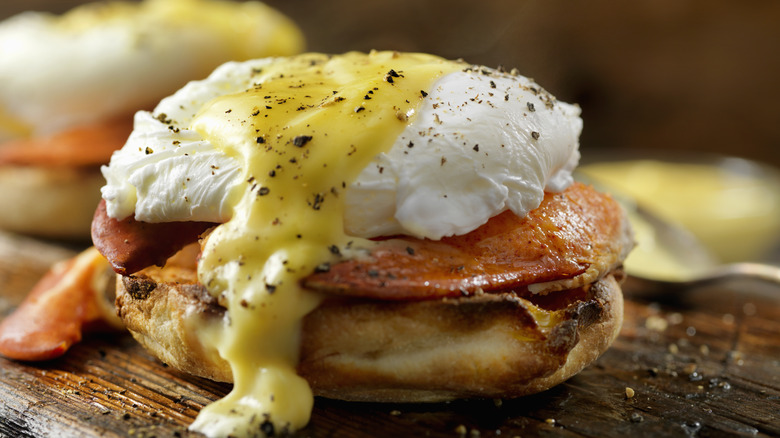Poached Vs Coddled Eggs: What's The Difference?
One of the beautiful things about eggs is their versatility. There are only so many ways to cook a New York strip steak, but there are seemingly infinite preparations of eggs, from sunny side up to scrambled to hard-boiled. Granted, some of these are pretty similar to each other — as the names suggest, over easy, over medium, and over hard are gradations of the same cooking method — but they still have their differences.
Take, for example, poached and coddled eggs. Both are relatively soft-cooked eggs (at least compared to something like scrambled), and both involve water as part of the cooking process. But the two approach that water very differently, with a poached egg being dropped directly into a swirling pot of water and a coddled egg cooked inside another vessel which is itself subject to a water bath. The end result produces radically different egg styles with radically different purposes.
Poached eggs are the classic you've probably had
Of the two preparations, it's far more likely you've had a poached egg. If you've ever been to any brunch anywhere, you've likely seen one, because they're an inextricable component of one of the most iconic brunch dishes: Eggs Benedict. You can't make the dish without them, nor substitute something like scrambled eggs or a fried egg, and still call it a Benedict.
Poaching eggs is easy once you've done it before, but it can feel tricky for newbies. The process, however, is simple: bring a pot of salted water to a boil, then add a small amount of white vinegar or apple cider vinegar. Get the water swirling really well, then drop the egg into the resulting water tornado (the swirl helps the egg whites stay wrapped around the yolk rather than spreading out). After a few minutes, it's done. The end result is an egg with a velvety, over-easy yolk that flows out when you break into it, and whites that are fully set without having been dried out (on account of the moisture they absorb during the process). This method isn't the only way to poach an egg, but it's the most classic technique.
Coddled eggs never actually directly touch water
Coddled eggs, though, are even simpler than that. In fact, when you coddle an egg, the egg itself never touches the water. Instead, it's placed inside a ramekin which is itself placed inside another vessel with boiling water up to near — but not over! — the ramekin's edge. The end result is that the egg cooks in two directions: the inside is cooked from the heat of the ramekin, while the top is cooked by the steam evaporating from the water. There are actually a couple of ways to cook a coddled egg like this — you can do it on the stove or in the oven — but both result in the same endpoint.
That endpoint is an egg with a runny yolk like a poached egg, but where the inner whites are visibly softer than the outer whites. Think of it like the sunny side up to the poached eggs over easy. You have to be ok with soft whites if you enjoy a coddled egg, and if that's your jam, they're generally a lot easier to make than a poached egg. Heck, you don't even have to take them out of the ramekin; they're made to be eaten in the container in which they're cooked.
It's true that you can't use a coddled egg in Eggs Benedict, but that doesn't mean you should skip giving it a try. Give both a shot and see which style you prefer.


